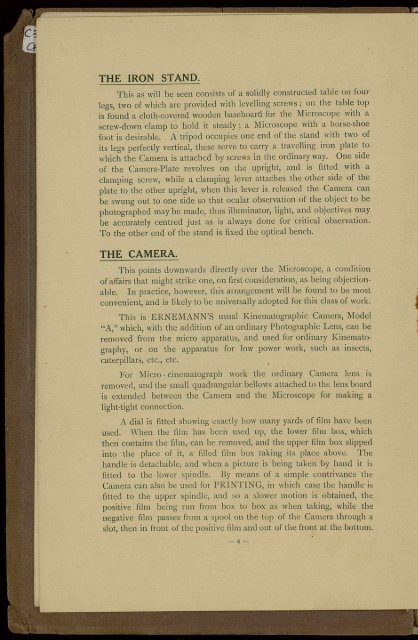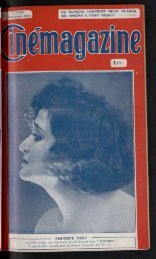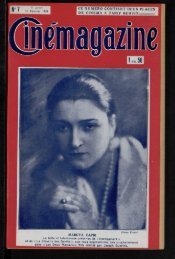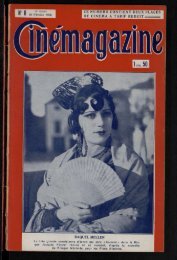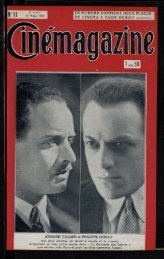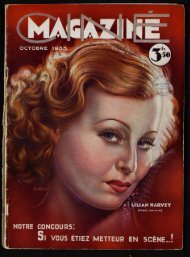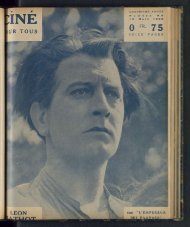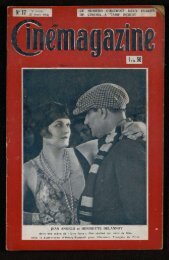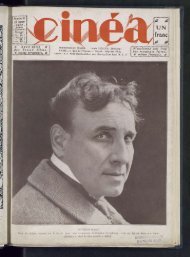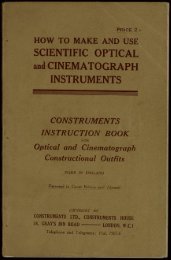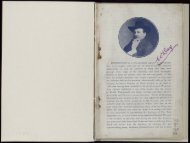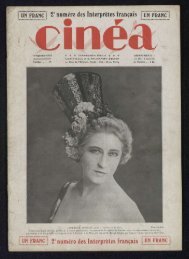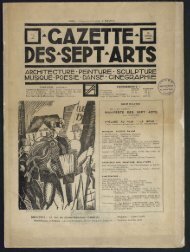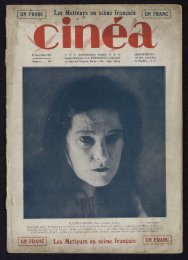Ernemann-Synchronismus, Ausführung I
Ernemann-Synchronismus, Ausführung I
Ernemann-Synchronismus, Ausführung I
Erfolgreiche ePaper selbst erstellen
Machen Sie aus Ihren PDF Publikationen ein blätterbares Flipbook mit unserer einzigartigen Google optimierten e-Paper Software.
THE IRON STAND.<br />
This as will be seen consists of a solidly constructed table on four<br />
legs, two of which are provided with levelling screws ; on the table top<br />
is found a cloth-covered wooden baseboard for the Microscope with a<br />
screw-down clamp to hold it steady : a Microscope with a horse-shoe<br />
foot is desirable. A tripod occupies one end of the stand with two of<br />
its legs perfectly vertical, these serve to carry a travelling iron plate to<br />
which the Camera is attached by screws in the ordinary way. One side<br />
of the Camera-Plate revolves on ihe upright, and is fitted with a<br />
clamping screw, while a clamping lever attaches the other side of the<br />
plate to the other upright, when this lever is released the Camera can<br />
be swung out to one side so that ocular Observation of the object to be<br />
photographed may be made, thus illuminator, light, and objectives may<br />
be accurately centred just as is always done for critical Observation.<br />
To the other end of the stand is fixed the optical bench.<br />
THE CAMERA.<br />
This points downwards directly over the Microscope, a condition<br />
of affairs that might strike one, on first consideration, as being objectionable.<br />
In practice, however, this arrangement will be found to be most<br />
convenient, and is likely to be universally adopted for this class of work.<br />
This is ERNEMANN'S usual Kinematographie Camera, Model<br />
"A," which, with the addition of an ordinary Photographic Lens, can be<br />
removed from the micro apparatus, and used for ordinary Kinematography,<br />
or on the apparatus for low power work, such as insects,<br />
caterpillars, etc., etc.<br />
For Micro - cinematograph work the ordinary Camera lens is<br />
removed, and the small quadrangular bellows attached to the lens board<br />
is extended between the Camera and the Microscope for making a<br />
light-tight connection.<br />
A dial is fitted showing exactly how many yards of film have been<br />
used. When the film has been used up, the lower film box, which<br />
then contains the film, can be.removed, and the upper film box slipped<br />
into the place of it, a filled film box taking its place above. The<br />
handle is detachable, and when a picture is being taken by band it is<br />
fitted to the lower spindle. By means of a simple contrivance the<br />
Camera can also be used for PRINTING, in which case the handle is<br />
fitted to the upper spindle, and so a slower motion is obtained, the<br />
positive film being run from box to box as when taking, while the<br />
negative film passes from a spool on the top of the Camera through a<br />
slot, then in front of the positive film and out of the front at the bottom.<br />
When the Motor is being used the handle is entirely removed.<br />
The Camera is made of mahogany, covered with the best leather,<br />
and is but little larger than an ordinary magazine camera.<br />
The Camera as supplied with this outfit is fitted with a means<br />
of direct Observation of the object all the time it is being<br />
photographed.<br />
In place of the usual lens, a quadrangular bellows several inches<br />
long is attached to the lens board, this is for making a light-tight<br />
connection between the Camera and Microscope. At the back of the<br />
lens board is a prismatic arrangement of optical glass through which the<br />
image is projected on to the film. The glass reflects the image from<br />
the face of the film, and it can be carefully and exactly watched by<br />
the Operator through the magnifying loup tube which projects from the<br />
side of the Camera.<br />
Although direct Observation is obtained through the magnifying<br />
loup tube projecting from one side of the Camera, it is but a moment's<br />
work to slip the expanding bellows off the Microscope and swing the<br />
Camera clear for direct Observation through the Microscope itself. In<br />
this way critical Observation can be made direct at the Microscope, and<br />
with the minimum of time the Camera can be thrown into line, extension<br />
bellows fitted, and photograph taken, and the Observation, during the<br />
whole Photographie period, continued through the magnifying loup tube<br />
of the Camera.<br />
THE OPTICAL BENCH<br />
is a carefully planed up and trued iron girder, which carries riders<br />
to which are attached the various Attings, namely : the illuminant,<br />
condensers, light-filters, etc. ; these riders have clamping screws and<br />
are all accurately centred, with means of using oblique illumination if<br />
necessary. With the outfit, is included an Are Lamp having all movements<br />
by rackwork, for swinging, tilting, advancing top carbon alone,<br />
feeding both carbons simultaneously, etc., etc. The lamp is supplied<br />
complete with resistance for one or two hundred volts, three ampere,<br />
so that current can be taken from an ordinary house lamp socket.<br />
Next, is a 60mm. diameter condenser, an adaption of the Herschel<br />
type, consisting of a combination of a meniscus and piano convex lens,<br />
and which in practice gives a most even field of illumination, almost<br />
entirely free from spherical aberration, a point of the very greatest<br />
importance in the lighting of micro slides or speeimens.<br />
Between the light and the swivel minor at the base of the<br />
Microscope, is a liquid light filter and heat absorber, which appears to<br />
- 5 -


